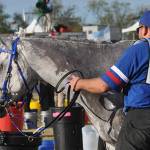Endurance Horse Lameness: Trainer Experience as a Factor

Lameness remains a top reason for elimination of endurance horses during competition. Do you know the most common injuries and the risk factors for those injuries? Trainer knowledge and experience ranked high as a risk for lameness in a recent study performed by researchers at the University of Perugia, Italy.*
In this retrospective study, experienced veterinarians evaluated 235 endurance horses between January 2007 and December 2018. All clinically relevant orthopedic injuries, defined as those injuries that developed during or after competition for which the owner requested veterinary assessment, were identified. Seventy-six percent of examined horses had orthopedic injuries, with some horses having more than one.
Lameness occurred most frequently in the fetlock, the region near the high suspensory ligament, and the hoof. About 70% of all lameness were pinpointed to these locations. More specifically, most injuries (77%) were noted in the forelimbs.
The authors detailed explicit causes for the lameness. “Some of the most common causes of lameness diagnosed in the fetlocks included some form of joint disease, such as osteoarthritis,” noted Kathleen Crandell, Ph.D., a nutritionist at Kentucky Equine Research and an endurance enthusiast.
“Arthritis and other joint diseases respond positively to the administration of joint supplements that contain glucosamine and chondroitin sulfate. In fact, some cases of osteoarthritis can be mitigated when owners offer quality joint supplements prior to the onset of joint trauma,” Crandell added.
In some of the study horses, lameness was severe enough that it not only resulted in elimination from competition but also retirement from their athletic careers.
“This highlights the need for pre-emptive management of musculoskeletal conditions, such as osteoarthritis and other inflammatory joint conditions, to prolong a comfortable, competitive career,” advised Crandell.
Another interesting finding of the study was that horses competing at the novice level were four times more likely to be injured, particularly in the high suspensory region. The researchers felt this was attributable to increased work intensity. In addition, horses being trained by amateurs were 162% times more likely to develop orthopedic injuries than those trained by professionals.
“Amateurs may not be able to recognize subtle signs of maladaptive responses, which may increase the odds of developing an orthopedic injury,” wrote the researchers.
“Typically, trainers back off conditioning programs when signs of maladaption develop, whereas amateurs may be more focused on the training schedule. Pushing sensitive soft tissues, like the high suspensory, with too much fast, downhill work before they adapt to the strain can mean derailment of even the best-laid training program,” cautioned Crandell.
In conclusion, the researchers said, “Considering the frequency and the amount of repetitive stress that endurance horses undergo in training and competition, prevention of injuries is vital because, when they develop, the chance of a long athletic career may be reduced.”
To prolong your horse’s soundness, choose high-quality joint supplements containing glucosamine, chondroitin sulfate, MSM, and hyaluronic acid.
*Paris, A., F. Beccati, and M. Pepe. 2021. Type, prevalence, and risk factors for the development of orthopedic injuries in endurance horses during training and competition. Journal of the American Veterinary Medical Association 258(10):1109-1118.








